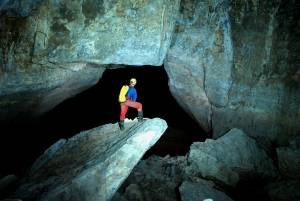
Exploration 2012
Caving in the Abode of the Clouds Project, Meghalaya, N E India.
The 2012 Caving in the Abode of the Clouds Expedition took place between the 5th to 25th February 2012. This year’s event was of particular significance in that it marked the 20th Anniversary of the projects exploration activities in Meghalaya that began in 1992.
The expedition focused on two separate areas, the first being in the areas of Kseh, Larket and Khahnar in the Jaintia Hills and the second in Mawsynram and Balat areas of the East Khasi Hills.
This year, the now traditionally International Caving in the Abode of the Clouds Expedition Team, comprised of a total of 24 cavers drawn from Austria, Belgium, Germany, Iran, Portugal, Romania, Switzerland, the UK, the USA, the Indian Navy and members of the Shillong based Meghalaya Adventurers Association. In addition to this the expedition team in the East Khasi Hills was joined by a Iranian film crew of four who are making a documentary about the Caving in the Abode of the Clouds Project and Cave exploration in Meghalaya.
During Over the 16 day exploration period (February 7th to 22nd) in the Jaintia Hills two previously known and partially explored caves were extended and 9 new caves were explored to yield at total of 6.8kms of new passage. In the East Khasi Hills five previously known and partially explored caves were extended and ten new caves explored to yield 5.9kms of new passage. Thus giving a grand total of 12.7kms of new surveyed passage for the expedition.
The main achievements from the 14 strong Expedition Team based in the Jaintia Hills were:
- Krem Khung in the Larket Area was explored for 5,120m along very impressive passage often strewn with massive boulders to reach a pitch overlooking a large lake that is very much ongoing.
- Krem Labit Kseh in the Kopili Valley was extended from 6,002m to 6,390m in length. This cave that consisting of a mix of fine river passage and dry relic passages with marvelous gypsum and aragonite formations remains as India’s 10th longest cave.
- Krem Man Krem, which had been left with a promising lead in 2010 was extended from 4,695m to 5,200m. The end of the cave is now very near the surface and close to the Lamyliang Doline – clearly indicating another drain from the Umkyrpong plains through the hill towards the Kopili River.
- The other achievements included the locating and a started survey of Krem Lymke and Krem Tin respectively, which are both ongoing, the surveying of Krem Suna and Um Krem, the discovery of 9 new caves and the documentation of various cave fauna in the caves in the area.
The main achievements from the 10 strong Expedition Team in the East Khasi Hills were:
- Krem Mawpun, this impressive river cave formed mostly in sandstone rather than limestone and partially explored in 2010 was extended from 1,694m to 2,541m to become India’s 2nd longest sandstone cave known to date.
- Krem Lymbit, located in the village of Plangwangbro, formed in sandstone and partially explored in 2010 was extended from 826m to 1659m. In the same village Krem Loit was explored for 685m
- Krem Jynnaiw 1, 2 and 3, partially explored in 1992 were all extended (Krem Jynnaiw 1 from 33m to 82m in length, Krem Jynnaiw 2 from 70m to 116m in length and connected to the Jynnaiw 3 that was extended from 670m to 1,366m)
- Krem Mawjudock, a relic cave with a huge bat colony located deep within the forest only yielded 423m despite its impressively sized main passage.
To date (February 2012) the whereabouts of over 1,300 caves and cave locations are known in Meghalaya of which 825 have been explored or partially explored to yield in excess of 376.7 kilometres of surveyed cave passage, with much more still waiting to be discovered.
To mark the end of Caving in the Abode of the Clouds 2012 and the 20th year of exploration a party was held in Shillong on 24th February. Expedition members and officials and friends from across Meghalaya and Shillong attended this event. Along with a small team of four from the Bristol Exploration Club (UK) who are working in parallel with the 2012 Caving in the Abode of the Clouds Expedition to explore caves in the South Jaintia Hills. Significant about this team is that it contains two of the original 1992 Caving in the Abode of the Clouds team members, who along with another member from the main expedition meant that three of the original 1992 team were present.
Much of the cave that has been explored in Meghalaya over the last 20 years consists of impressive river cave mixed with massive and often richly decorated relic passage along with magnificent clean washed shafts that create cave systems equal in size and beauty to those found elsewhere in the world, maintaining Meghalaya’s status on the world-caving map as a significant caving region.
In the achievement of the above the Caving in the Abode of the Clouds Project is indebted to the help and support it has received from: The Meghalaya Adventurers Association (Shillong), the Government of India Tourist Office (East and North East India) Kolkata; the Meghalaya State Tourism Department; Officials and Government Departments within Meghalaya, Grampian Speleological Group; and, very importantly, the People of Meghalaya.
Simon Brooks and Thomas Arbenz
2012 Expedition – Caving in the Abode of the Clouds Project, Meghalaya, India.
